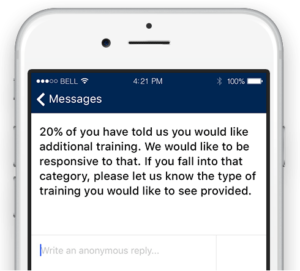3 Best Practices for Creating a Post-Survey Employee Feedback Action Plan
Are you taking action on your survey results, or are they just collecting dust?
Executives everywhere are searching for better ways to improve employee engagement, and the solutions are a dime a dozen. Do workers need flexible schedules and wellness programs to be more productive, or on-the-job perks and compensation-based incentives? Are frequent pulse surveys fixing or exacerbating current issues with engagement?
You can’t know what’s going to be effective with your employees until you measure their current engagement. But you can’t measure until you ask the right questions.
And you won’t be able to ask the right questions until you have a clear plan for acquiring reliable insights—feedback you need instead of what employees think you want to hear—and acting on them.
The problem is that many companies will conduct surveys that lead to one of two common scenarios:
- The results aren’t specific enough to pinpoint opportunities for improvement, leading to actions that are too broad to be impactful.
- The data is too overwhelming to act on at all, which ultimately leads to inaction as disengagement grows.
Having an employee feedback action plan in place before conducting a survey makes a mountain of difference.
As specialists dedicated to the field of measuring employee engagement, 15Five have spent a lot of time researching which types of employee engagement surveys lead to actionable data. The following three best practices are based on in-depth behavioral science research as well as our own experiences measuring and improving engagement among thousands of employees.
1. Ask the “Right” Questions
When employee engagement surveys result in inaction, it’s often because the questions are flawed. The most common mistake we’ve seen: asking questions that gauge job satisfaction but don’t measure true engagement.
By writing psychometrically valid questions—ones that get at the heart of psychological conditions proven to affect engagement—you’ll ensure your survey addresses engagement instead of satisfaction alone. This can be especially valuable any time leadership suspects potential problems within a particular department. By asking questions that are grounded in psychology, you can identify which specific issues need to be addressed by viewing the results based on things like team, tenure, and location.
2. Ask Deeper Probing Questions
 When pulse surveys lead to “survey fatigue” and result in unreliable feedback, it’s because they’re misused and sent too frequently. Quick polls, on the other hand, can be an incredibly effective way to get at the heart of specific engagement issues once problem areas have been discovered.
When pulse surveys lead to “survey fatigue” and result in unreliable feedback, it’s because they’re misused and sent too frequently. Quick polls, on the other hand, can be an incredibly effective way to get at the heart of specific engagement issues once problem areas have been discovered.
Take 15Five’s customer Arbor Homes, for example. When the company’s survey revealed that 20% of employees didn’t feel they were receiving enough training, leaders used a quick mobile poll to find out what types of training opportunities they’d like to see. Asking follow-up questions and making it easy for employees to respond both quickly and anonymously will allow you to act quickly on relevant, honest feedback.
3. Publicize Changes as They’re Made
When employees see change being brought about by the feedback they’ve given, they’re more likely to give it again. Looked at from another angle: Your engagement surveys will never be effective unless they lead to noticeable change. Taking action on the data you collect not only brings about positive change for the company, but also reinforces to employees that leadership is listening…and makes them more likely to continue participating in subsequent surveys.
Don’t forget to do your own internal PR and publicize any changes as they’re being made. We’ve seen instances where even a single, simple change that’s tied directly to a quarterly survey resulted in a heightened sense of trust in leadership.
In Conclusion:
Once you have a clear plan for acting on employee feedback, your engagement surveys will take a noticeable turn for the better. Focus on asking the right questions to get at the heart of true engagement issues, and then be sure to let employees know what changes you’re implementing as you take action.




